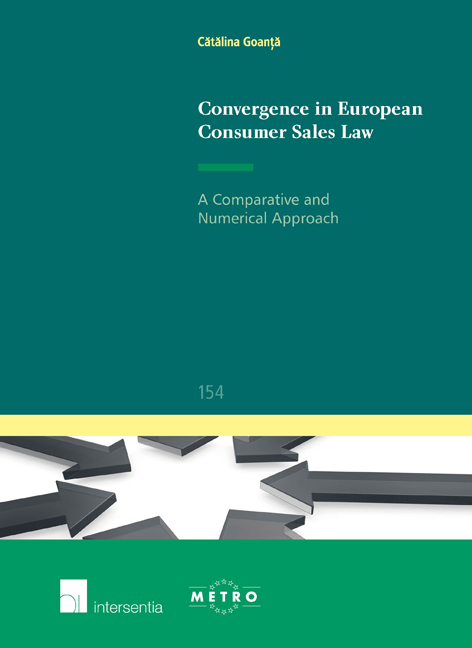Book contents
- Frontmatter
- Dedication
- Acknowledgements
- Contents
- List of Abbreviations
- List of Tables and Figures
- Chapter 1 Introduction
- Chapter 2 The Substantive Comparison
- Chapter 3 The Numerical Analysis
- Chapter 4 Conclusions and Recommendations
- Summary
- Valorisation Addendum
- Relevant Documents
- Bibliography
- Other Literature
- Curriculum Vitae
- Ius Commune Europaeum
- Frontmatter
- Dedication
- Acknowledgements
- Contents
- List of Abbreviations
- List of Tables and Figures
- Chapter 1 Introduction
- Chapter 2 The Substantive Comparison
- Chapter 3 The Numerical Analysis
- Chapter 4 Conclusions and Recommendations
- Summary
- Valorisation Addendum
- Relevant Documents
- Bibliography
- Other Literature
- Curriculum Vitae
- Ius Commune Europaeum
Summary
This is an empirical study about the converging effects of harmonisation policies used by the European lawmaker in consumer sales law. It aims to fill a gap in existing literature, by looking into what European consumer sales law harmonisation has achieved, and trying to develop a methodology to measure the convergence it has led to. The study encompasses both a substantive comparison as well as a numerical approach. While in the former, five directives and their subsequent transposition in the national laws of Member States are analysed, the latter focuses on the creation of the Convergence Index as a measurement tool for the effects of the harmonisation process. This research is dedicated to both academics as well as policy makers, as it aims to trigger more debate regarding benchmarking in European consumer law. Such a debate can play a role in further academic research aimed at determining whether harmonisation does indeed strengthen the internal market.
The study consists of four chapters.
Chapter 1 addresses the background to globalisation and legal convergence. Legal convergence, as a result of globalisation, is firstly defined, and subsequently explained by making an inventory of the driving forces behind it. This is essential for the clarification of a concept (‘convergence’) that has until now been used in many different ways and contexts. The chapter then places further emphasis on one specific policy behind convergence: the harmonisation of laws as practiced by the European Union. This opens the way for defining the aims and methodology of this study. Moreover, the Chapter also includes a discussion on the novelty of the study as well as its limitations. In laying the background for the rest of the study, Chapter 1 includes a brief historical scrutiny of European harmonisation as a policy tool that is supposed to achieve convergence. Harmonisation is then examined from a chronological point of view, and its types, as well as the competence of the European legislator to pursue this policy are addressed.
- Type
- Chapter
- Information
- Convergence in European Consumer Sales LawA Comparative and Numerical Approach, pp. 313 - 320Publisher: IntersentiaPrint publication year: 2016

